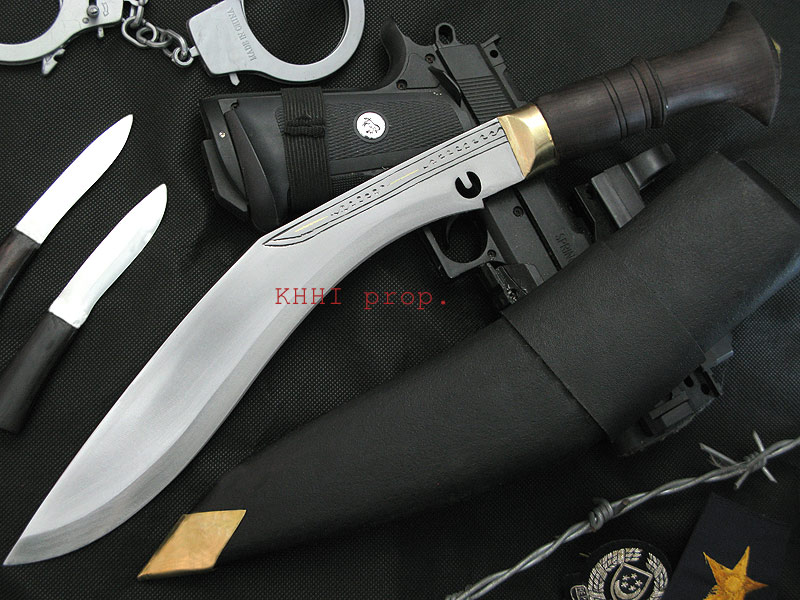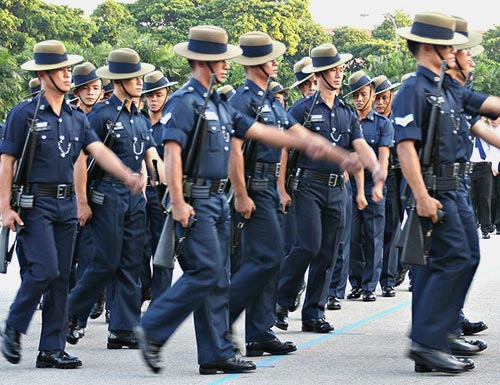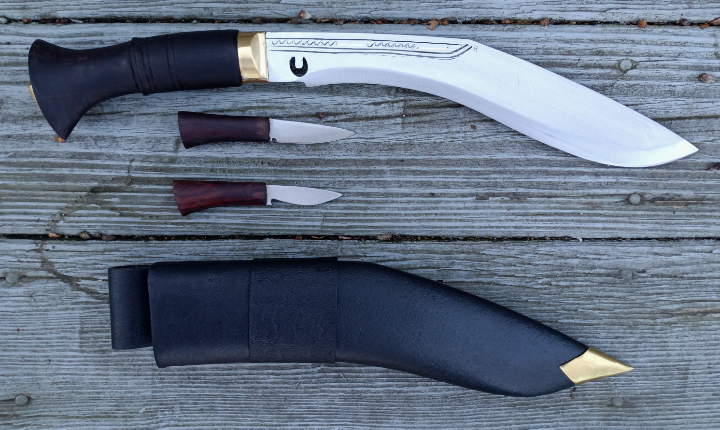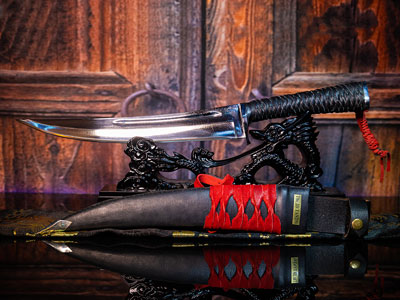
Gurkha Jungle (Gurkha Contingent, SPF)
the second issue khukuri of Singapore Police Force Gurkha Contingent (SPFGC) for training, exercise, assignments and special tasks..
Delivery: Estimated between May 20, 2024 and May 30, 2024
Item Location: Nepal
Default Specification
- Blade Size (in): 11
- Handle Size (in): 5.5
- Handle Material: Rosewood
- Actual Weight (gm): 500
- Overall weight (gm): 725
- Shipping weight (gm): 1075
- Blade finishing: Unpolished
- Blade sharpness: Standard (very sharp)
- Blade material: 5160
- Place of Origin: KHHI, Kathmandu, Nepal
- Accompanying knives/B-up: Karda Chakmak
- Blade thickness (mm): 8
- Handle finishing: Unpolish
- Sheath: Black leather
- Tang type: Rat-Tail
- Fixture: Brass
- Edge grinding: Semi convex
- Edge Hardness: 55-57 hrc
- Blade (panel) Grinding: Full Flat
- Function: Attacking, Trekking, Domestic use, Stabbing, Lethal, Military, Combat, Jungle warfare, Regular Work
Gurkha Jungle Khukuri for SPFGC; a working and utility knife for policemen..
'Gurkha Jungle' is the second standard service issue khukuri of the famous Singapore Police Force Gurkha Contingent or “SPFGC” (explained below). Personnel are issued with this full unpolished kukri knife for training, exercise, assignments and for special tasks. Unlike the British Gurkha's “no.2” version, this khukuri of SPFGC is completely different. Its made in “ChainPure” version. The selection committee has decided to go with this type of khukuri probably to easily differentiate it from the parade version and perhaps to distinguish it from the British Gurkha’s type.
The ChaiPure format in which the “Gurkha Jungle” is made from is a lighter and slender version. This version has been specifically chosen to ease the work and carry load for a policeman. Moreover with the addition of 1 inch to the standard 10 inch long gives more coverage and range.
The Gurkha Jungle / Service no.2 Khukuri (Kukri) as a knife

The blade is 11 inches long, totally unpolished from tip to ricasso forged in the village model the “ChainPure” having the regular closed notch. The pointed nozzle in from of the notch is the blood dripper. The blade also has the regular brass inlay pattern of the ChainPure. A rat tail tang goes through the handle (hidden) which is peened over at the brass keeper at the extreme end of the handle. The regular metallic bolster is discarded and replaced by an ace-shaped keeper to secure the tang at the butt section. Fine contours of the handle also provide easy and strong hold.The total unpolished format also gives advantage as it enhances the cutting ability and durability of the blade as losing of temper is prevented by avoiding the long machinery process undertaken to polish it.
The scabbard is plain and simple made from water buffalo hide. It has a single loop belt holder (frog) for the belt to go through to carry from waist level. A protective brass chape (tip) is also fitted in the scabbard for support and look.
The Gurkha Jungle kukri comes with two small accompanying knives, (see picture) the KARDA (small utility knife) and CHAKMAK (sharpener), both totally unpolished and made in wooden handle like the mother blade.
It is an all-out all-purpose utility knife that carries the history and also has all characters of an assault knife.
What is Singapore Police Force Gurkha Contingent or SPFGC?
 The Gurkha Contingent or “GC” is a line department of the “Singapore Police Force”. Members of the GC are trained to be highly-skilled and are selected for their display of strong discipline and dedication in their tasks. The principal role of the contingent is to be a special guard force, and is currently used as a counter-terrorist force.
The Gurkha Contingent or “GC” is a line department of the “Singapore Police Force”. Members of the GC are trained to be highly-skilled and are selected for their display of strong discipline and dedication in their tasks. The principal role of the contingent is to be a special guard force, and is currently used as a counter-terrorist force.
The GC was formed on 9 April 1949 in the wake of Indian independence from the British Empire, where Gurkhas battalions from the British Indian Army were divided between the Indian Army and the British Army. Those transferred to the British Army were posted to other remaining British Colonies, and Singapore being one of them.
After Singapore gain independence form the British, GC played a crucial role in controlling riots and violence amongst the ethnic groups that threatened the very existence of the new born country. Their presence as a neutral force was important because local police officers were often perceived to be (or were even expected to be) biased towards their own ethnic groups when handling racial disturbances, further fueling discontent and violence. Thus the Gurkha Contingent as an impartial force at the time stabilized the country and its sovereignty as personnel (Nepalese) in GC were Nepalese hailing from another country, religion and background. Nepalese were more than perfect and suited for the job and hence were integrated to the national security force of the country forming “Singapore Police Force Gurkha Contingent” or “SPFGC”.







